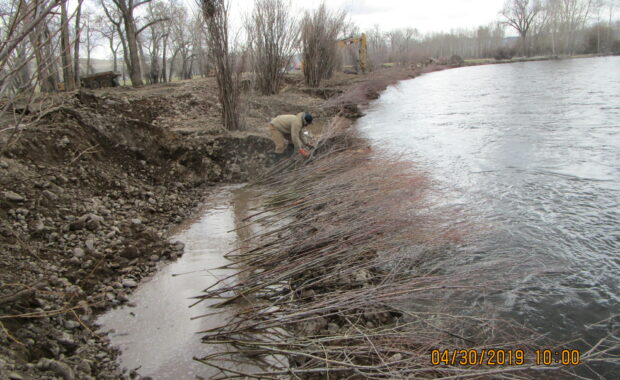In northern latitudes and high elevations the strategies for revegetation are greatly affected by seasonal temperature and precipitation patterns. The high valleys (>5000 feet) of southwest Montana may enjoy a 100-day frost-free growing season, at best. Much of our annual revegetation efforts occur between late-September and November. Controlling undesirable vegetation, sowing native seed, and planting shrubs and trees are often best performed during the beginning of the so-called “dormant season”. The dormant season in southwest Montana can easily be six months in duration.
Controlling noxious and nuisance plants is often an initial step for successful revegetation. Hardy perennial plants undergo dramatic changes in phenology and physiology once a significant frost occurs. Carbohydrates and other nutrients stored in above-ground plant biomass are translocated into the root system for sustenance of the plants through the winter. After a hard frost, many selective herbicides are very effectively absorbed into and throughout the root mass for an optimal systemic effect to control the undesirable species. In Montana, frost and fall precipitation are both likely in early September. One must also consider the use of persistent herbicides (long half-lives), and the appropriate duration of time after their application until one should sow seed.
Application of native grass, forb, and shrub seeds is often best performed in the fall. One reason is that many native plants under natural site conditions will set seed in the fall. Thus, fall seeding mimics a natural process. Also, seed of native plants that are adapted to cold climates require multiple severe cold events to prepare the seed for onset of germination in spring. Perhaps the best reason for conducting fall seeding is to place seed in direct contact with the soil before the soil freezes and snow accumulates. The snowpack presses the seed into the soil, the seed enjoys the entire duration of spring snowmelt and rain, and the applicator does not struggle with mud and snow during the spring.
Streambank and floodplain stabilization are primary objectives of watershed restoration projects. Willow establishment is often a means of fulfilling that objective. Conventional wisdom dictates that the excavation work be performed well before or soon after spring runoff. On wild and free flowing rivers and streams, planting woody vegetation along banks and flood prone areas can be problematic during spring break up. Ice and debris jams, multiple flood-stage events, and saturated surrounding landscapes make for tough scheduling of fluvial restoration projects. To compound the challenges, many river restoration vegetation professionals insist that transplanting willow cuttings be completed before bud stage of willow growth. Consequently, much of the willow transplanting is performed well after high flows, as water table elevations decline. Unfortunately, many willow installations are marginally successful. A significant and growing number of practitioners are now advocating fall planting of willows in streambank and wetland restoration projects. The conditions that favor successful willow establishment with fall planting include: 1) Harvest cuttings, whips, whole plants after complete leaf drop; 2) Donor plants should have been exposed to freezing conditions before cuttings are gathered and transplanted; 3) Pre-soaking willows, whether harvested in spring or fall, appears to improve results; 4) Install cuttings at least two feet deep, to ensure freeze-thaw pressures do not push the cuttings out of the ground; and, as always 5) Install willow cuttings well into the water table elevation.
Submitted by John Whittingham, Owner, Hydrologist, Basic Biological Services LLC, Dillon, MT
PWS (#2155), CPESC (#3445), Montana Representative, MSC IECA

Montana Calendar Events
Missouri Headwaters Watershed Restoration Tour, September 11-13, Butte and Dillon, Montana
Contact rosie@mtwatersheds.org
Montana American Water Resources Association Annual Conference, October 9-11, Red Lodge, Montana, Contact mtwra.org
Montana Headlines
“EPA Awards Montana Department of Environmental Quality $1,041,000 to Protect Water Quality”
EPA is partnering with MDEQ to restore water quality by focusing on one of the nation’s largest remaining causes of surface water impairment, contaminated runoff from nonpoint sources.
